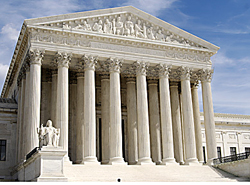A unanimous U.S. Supreme Court decision issued last Wednesday (June 25, 2014) listed the history of precise locations contained in the phone as an example of the information that individuals have a right to have protected against “unreasonable searches and seizures.”
The decision, delivered by Chief Justice John Roberts, Jr., addressed two cases in which cell phones were seized in unrelated incidents and ruled that the contents of cell phones are generally covered by the Fourth Amendment.
A unanimous U.S. Supreme Court decision issued last Wednesday (June 25, 2014) listed the history of precise locations contained in the phone as an example of the information that individuals have a right to have protected against “unreasonable searches and seizures.”
The decision, delivered by Chief Justice John Roberts, Jr., addressed two cases in which cell phones were seized in unrelated incidents and ruled that the contents of cell phones are generally covered by the Fourth Amendment.
“Historic location information is a standard feature on many smart phones and can reconstruct someone’s specific movements down to the minute, not only around town but also within a particular building,” Roberts wrote in his opinion. The decision adds to a growing body of court rulings that protect individuals’ whereabouts and the history of their movements, which have become increasingly prevalent as a result of GNSS and other location technologies.
Roberts referred to a previous decision issued in 2012 that ruled warrantless GPS-aided monitoring of a suspect also was unconstitutional. “GPS monitoring generates a precise, comprehensive record of a person’s public movements that reflects a wealth of detail about her familial, political, professional, religious, and sexual associations,” Justice Sonia Sotomayor wrote in a concurring opinion in that case.
In the case of David Riley, who was stopped for having expired registration tags on his car, which was impounded when he was discovered to have a suspended license as well, officers subsequently investigated the contents of a smartphone found in the car. Photos and videos found on the phone led police to charge Riley with a variety of crimes.
The Supreme Court ruled that the evidence found on the phone was inadmissible in court because a warrant was needed in order to conduct the seizure and search of the phone.
“The sum of an individual’s private life can be reconstructed through a thousand photographs labeled with dates, locations, and descriptions,” Roberts wrote, later adding, “Even an individual pulled over for something as basic as speeding might well have locational data dispositive of guilt on his phone.”





